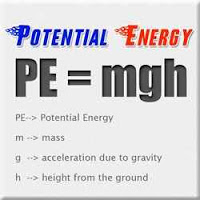Potential energy is often wrongly defined as the energy at rest. The correct definition of Potential Energy is that it is the energy possessed by an object due to its position or configuration.
Based on the word itself, objects that have potential energy must have the potential to do some work. A hanging flower vase has potential energy because it can do work if it falls to the floor.
Thus, the formula for Potential Energy is PE = mgh where PE stands for Potential Energy, m for mass, g for the acceleration due to gravity and h for the height of the object from the ground.
Potential Energy Practice Problem
Solve this problem using the potential energy formula.
- 1
Identify the given in the problem. We know that the mass of the fruit is 0.25 kg because it is a quarter of a kilogram. We also know that the fruit is 10 meters above the ground.
Thus, these are the given in the problem:
Mass = 0.25 kg
Height = 10 m
Potential Energy = unknown - 2
Substitute the values in the Potential Energy Formula. You should already know that g, the acceleration due to gravity is constant and equal to 9.8 m/s2
PE = mgh
PE = (0.25 kg) (9.8 m/s2) (10 m)
PE = 24.5 J - 3
State the answer in a complete sentence.
The potential energy of the Marang fruit is 24.5 Joules.
Your Turn, Solve this Problem:
A 30 kg boulder is on top of an 80 m cliff. If the rock falls, how much is its potential energy when it reaches 30 m above the ground?
















